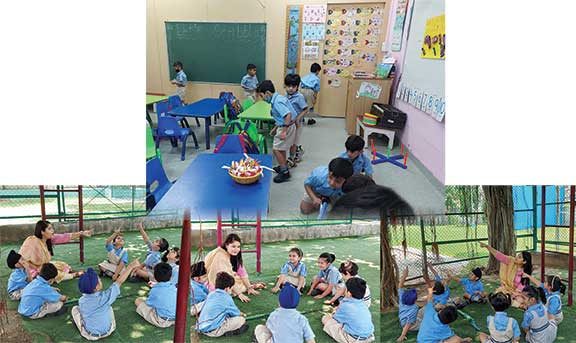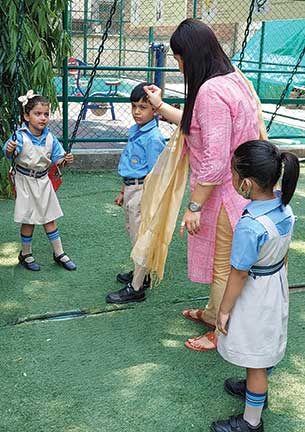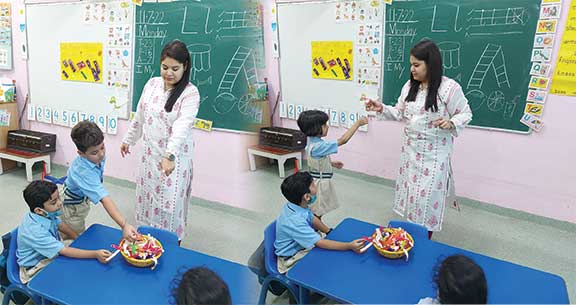Yukti Lao
“One looks back with appreciation to the brilliant teachers, but with gratitude to those who touched our human feelings. The curriculum is so much necessary raw material but warmth is the vital element for the growing plant and for the soul of the child.” – Carl Jung (Paterson, 2010)
Teachers are like foresters, planting seedlings that will grow and shape into responsible young minds. Teachers have immense power to change and transform the lives of young learners, become their role models, give them the tools and knowledge to live fulfilling, productive lives, and contribute to making the world more peaceful and compassionate. Language is the most powerful tool that teachers can use in this mission and how they use this tool is very important, for its wrong usage can lead to undesirable consequences for the students.
It was a pleasant April morning and Yashika decided to take her group of kindergarten students to the garden. They all sat under a tree in a circle. She asked them to look around and observe.
Yashika: Children, can you tell me where you are sitting?
Abeer: We are sitting on the grass.
Samaira: We are sitting under the tree.
Kabir (feeling shy): We are sitting outside.
Yashika: That’s great! Can you spot some birds here?
Aashvi: Oh yes! I can see a bird! Look, there…
Manasvi: I can see a big bird!
Maahir (excitedly): Oh! Me too. That’s an E…E… it has big wings.
Yashika: Maahir, aren’t you able to recall the name of the bird? It’s so easy.
Maahir (sadly): I don’t know ma’am.
Yashika: Oh dear…it’s so easy. We learned the name of that bird in our phonics class.
Abeer (happily): I remember, it’s Eagle!
Yashika: Well done! Now let’s take out the magnifying glasses I gave you and find some insects.
Jaagavi: Look here! I found some ants.

All the children rushed to the spot and found a row of ants marching up and down. Just then, Angad found a ladybug in the grass. The teacher was observing all the kids when she found a very happy Angad. She went up to him.
Yashika: Angad what did you find?
Angad: Look, teacher, that…it’s there on the grass.
Yashika: Well done Angad! Do you know the name of this insect?
Angad: No, I don’t. I have never seen it before.
Yashika: That’s fine dear! Angad, let’s ask your friends if they know. We will click its picture and carry it back to our class in an airy jar.
Angad was delighted to take his little new friend back to the class and show it to his friends. In the class, the teacher showed the ladybug and introduced it to all the children.
Later that day, Angad excitedly told his mother that he found a new insect in the grass and the teacher praised him and told them more about the ladybug in the classroom.
Maahir, on the other hand, felt sad, discouraged, and disappointed. He told his mother that he couldn’t recall the name of the bird; the teacher said it was easy… “What does easy mean, mom?”
This incident clearly shows the influence that teachers have on their students. Every word they speak has an impact on young minds. How teachers talk in class whether during instruction or otherwise becomes very important. Let’s take a moment to reflect on our own childhood and recall how teachers instructed us. What words did they use when teaching? What was the tone of their voice? How did we feel around these teachers? Did we feel safe to respond and motivated to learn? Or were we self-doubting, insecure, or angry? As we delve deeper, we realize how positive or negative experiences can stick with us for the rest of our lives. Educators need to remember that they hold great power over students. Their words truly matter.
Instructional vocabulary
The language a teacher uses in the classroom can either help students reach their highest potential or push them down a dark hole. It shapes how students think and learn. The use of the right language helps create a vision for the children and inspires them to do their best. As psychologist Lev Vygotsky said, “Language actually shapes thoughts, feelings, and experiences. It produces fundamentally new forms of behaviour.”
How words affect young children
Whether students take part in lessons and assimilate what they are being taught depends significantly on the nature of the teacher’s talk. According to teacher and author Paula Denton, a teacher’s words shape students as learners by:

• Affecting their sense of identity: Our words can shape identities. What we say to children can deeply affect their sense of who they are and who they can become. Four-year-old Esha loves to dance but isn’t good at it yet. Her dance teacher says, “You aren’t able to follow the steps. Go back and stand there.” Such language can lead Esha to believe that she is not a good dancer. But suppose the teacher had said, “Esha, you really love to dance, don’t you? Would you like to learn the basic steps first?” These words support Esha’s budding identity as she loves to dance and can help develop her dancing skills.
• Influencing teacher-student relationship: To a student who – once again – argued with her classmates at the swings, we can either say, “Jiya, if you don’t stop it, no more swing time!” or “Jiya, I saw you arguing with Sahil and Riya. Can you help me understand what happened?” The former will reinforce a teacher-student relationship based on teacher threats and student defensiveness, whereas the latter will begin to build a teacher-student relationship based on trust.
How can we as teachers and schools address this issue?
How can we ensure that our language supports students’ learning and helps create a positive, respectful community? For this, we need to create responsive classrooms. This approach offers language strategies that enable teachers to help students succeed academically and socially. Strategies range from asking open-ended questions that stretch students’ thinking to redirecting students when their behaviour goes off-track. These strategies are based on the following five general principles.
- Encouraging habits and strategies that lead to learning
When a teacher begins by saying, “I wonder how many different things we can observe out in the garden today,” it fosters in children the skill of careful observation and the attitude of curiosity. - Helping children learn from each other
Our language can also help children learn from each other and engage in ways that stretch their academic skills. For example, in the above incident, Abeer remembered the name of the bird, ‘E-Eagle’, from their phonics class. The teacher can initiate class discussions to enhance peer learning through collaborative projects in class. - Use simple and direct language
When we use a kind, straightforward tone, students learn that they can trust us. It’s basically saying what we mean, instead of beating around the bush. It’s then that children feel respected and safe in an environment, which helps them develop self-discipline. For example, to call the students for circle time, the teacher can ring a bell to gain their attention, then say firmly yet kindly, “Come and sit in a circle now.” This helps the learners develop self-control. - Influencing children to use language skilfully themselves
Children often begin using language more skilfully as they listen carefully to the teacher’s instructions. For example, when giving feedback on a student’s work, a teacher gives specific positive feedback such as, “Wow! You drew a plum as a summer fruit.” Rather than simply saying, “Good work!” In this way, students will also adopt the way of speaking when giving feedback to their peers. This results in a richer classroom that encourages cooperative learning with children more actively helping each other grow. - Conveying faith in students’ abilities and intentions
When our words and tone convey faith in students’ desire and ability to do well, students are more likely to live up to our expectations of them. “When everyone is ready, I’ll show you how to plant the seeds.” “Show me how you will follow the class rules.” These words if spoken in a calm voice, communicate a belief that students want to – and know how to – listen, cooperate, and do good work. This increases the chance that students will see themselves as respectful listeners, cooperative and competent workers, and behave accordingly. Take the time to notice and comment on specific positive behaviour, “You’re trying lots of different ideas to solve that puzzle. That takes persistence.” Such observations give students hard evidence for why they should believe in themselves. - Building a sense of community
A sense of belonging is a basic human need that we all have. For young children, this feeling is critical if they need to be motivated to learn. When they feel safe and valued, they are more willing to take risks and be cooperative with their classmates which leads to greater learning. By using language that encourages everyone to value and practice cooperation, respect, and empathy after a paper-tearing and pasting activity, a teacher says, “I noticed clean-up was done quickly today because you were all helping each other.” This gives children specific feedback about the aspects of their behaviour that were helpful. - Know when to be silent
The skillful use of silence can be just as powerful as the skillful use of words. When teachers use silence, they open a space for students to think, rehearse what to say, and sometimes gather the courage to speak. After asking a question, we pause before taking responses from students. Researchers have found that when teachers wait three to five seconds, more students respond, and those responses show a higher level of thinking. Our reward will be classroom conversations of higher quality.

By following the above-mentioned strategies, teachers can build classrooms where students feel safe, respected, and engaged. By paying attention to our language, we can use it to open the doors of possibilities for students. The goal is to create more positive associations in school, a greater majority of our students will begin to correlate “education” with “success” and “learning” with “fulfilment,” a perspective that these young learners must take with them as they lead towards the future.
Conclusion
The main role of the school is to help students grow and to empower them towards success in their life. One of the major factors that play an important role in this process is the way teachers instruct and talk to their students. Therefore, the effects of a teacher’s positive language such as praise, reinforcement, reminders as well as the use of appropriate humour or tone of voice with regard to students’ motivation and discipline consequently leads to school achievements.
Learning to use effective instructional vocabulary to its full potential means becoming aware of our habitual ways of speaking and the messages, positive or negative, that we may be sending to students. It means stepping back to hear ourselves and reflect, “What did I say? What tone did I use? How did the children respond? Were they engaged?” We can then practice using new words, phrases, tones, and pace to replace any ineffective language that we may be using in the classroom. Our classrooms become places where children learn to take care of themselves, their learning, each other, and the world in a different, more joyful way. Most importantly, better instructional vocabulary makes us better teachers and our students better learners.
The author is an English Literature graduate from Delhi University. Currently she is working as Kindergarten teacher at G.D. Salwan Public School, Rajendra Nagar, New Delhi. She can be reached at yuktilao@gmail.com.
Related Articles
